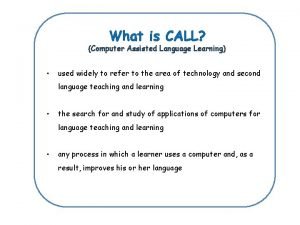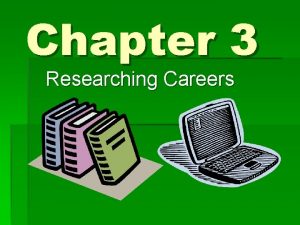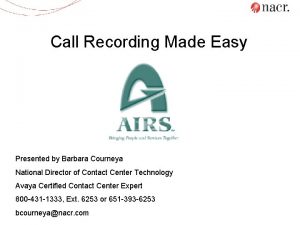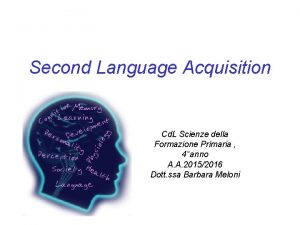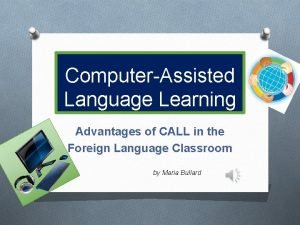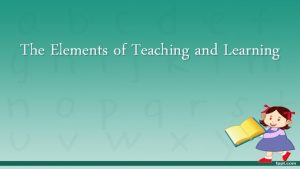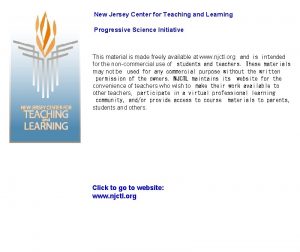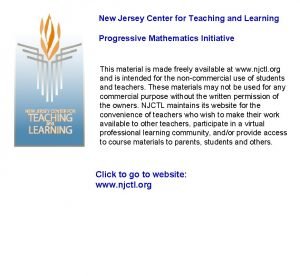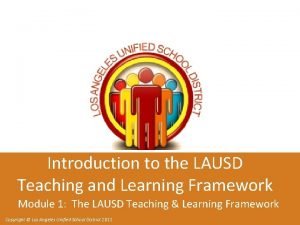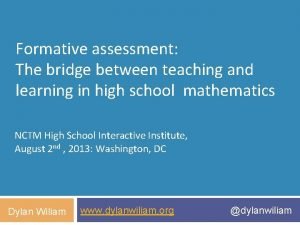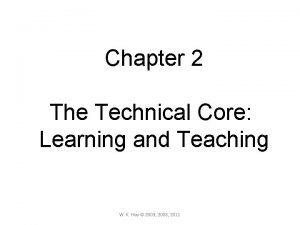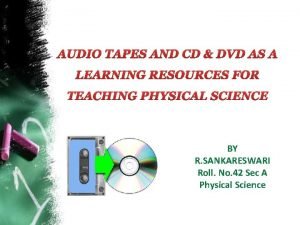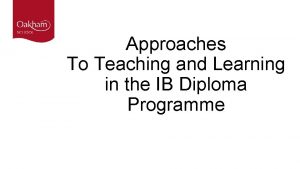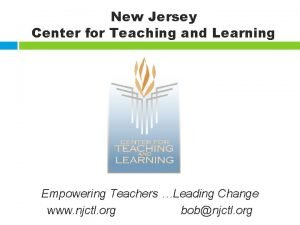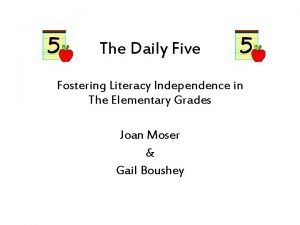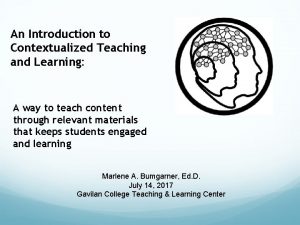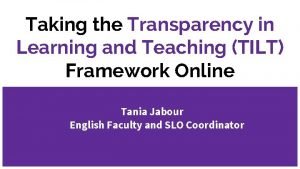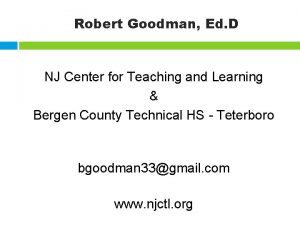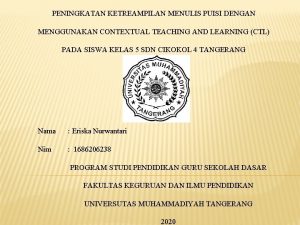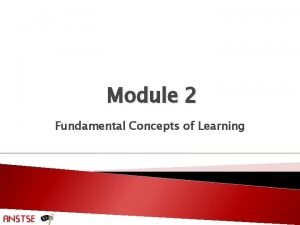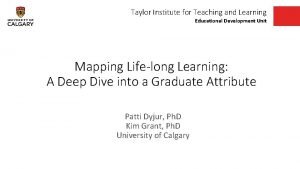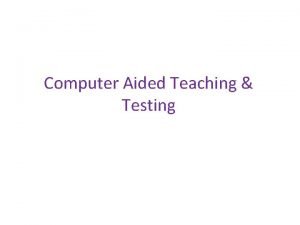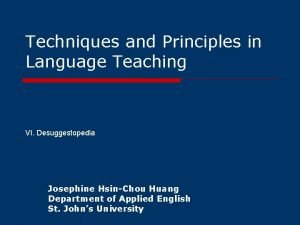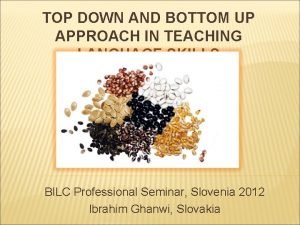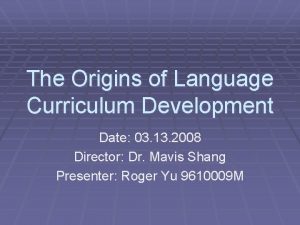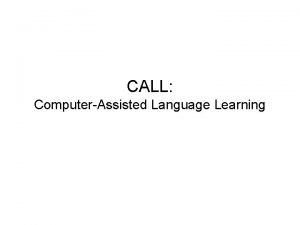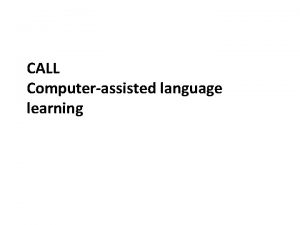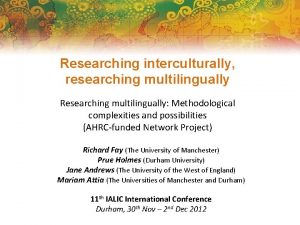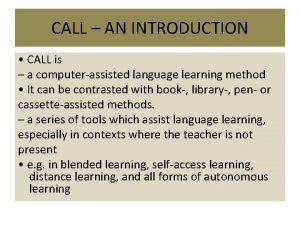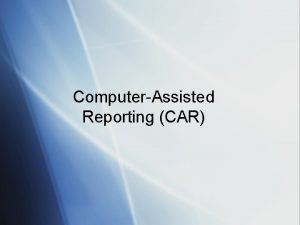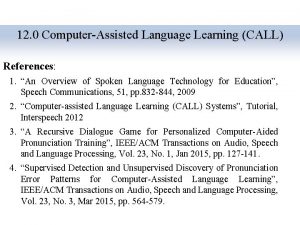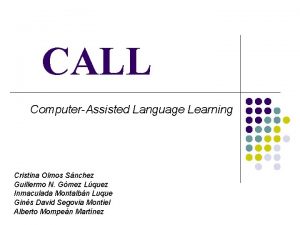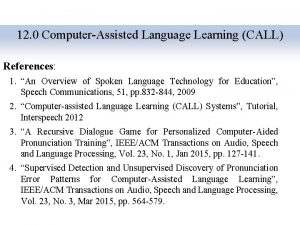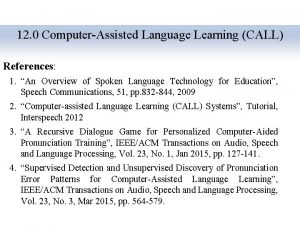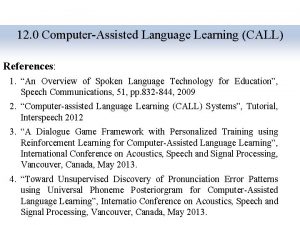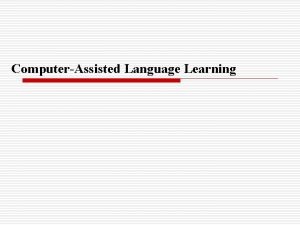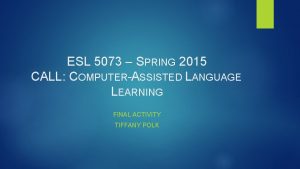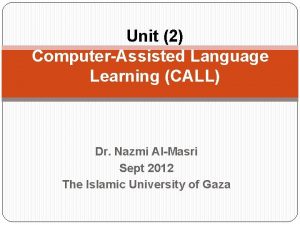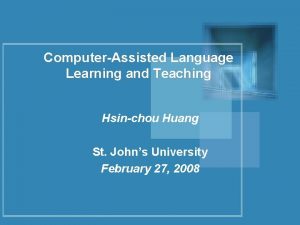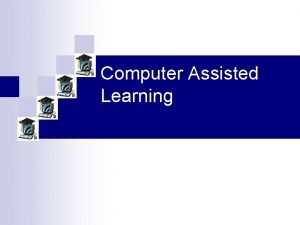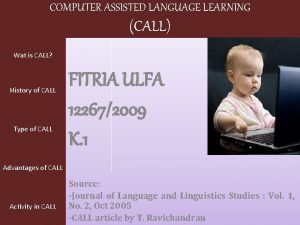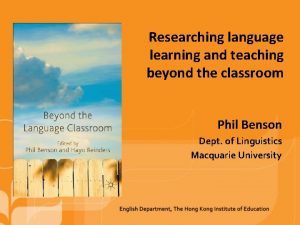Computerassisted language learning CALL Teaching and Researching Computer


































- Slides: 34

Computer-assisted language learning (CALL)

Teaching and Researching Computer. Assisted Language Learning Ken Beatty

Chapter one: The emergence of CALL Tayebeh Mousavi

Th main purposes of this presentation • 1. The key concepts of the chapter • 2. To explain the emergence of CALL • 3. To present the terms peripheral to CALL 4. To explain the changing focus of research in CALL

Introduction

• • CALL (Computer-Assisted language learning ) is filled with areas that are unknown and in need of exploration. Even where much is known, details have not been made clear or need to be made clearer as other factors and conditions change, such as the introduction of new technologies and broader adoption of existing technologies. The field of CALL is also constantly undergoing change because of technological innovation that creates opportunities to revisit old findings, to conduct new research and to challenge established beliefs about the ways in which teaching and learning can be carried out both with and without a human teacher. CALL is a subject tied tightly to other areas of study within applied linguistics such as autonomy and other branches of knowledge such as computer science. CALL is a young branch of applied linguistics and is still establishing its directions. This book aims to help in this task not just by discussing what we know and do not know, but also ways in which classroom teachers as researchers can look for answers on their own.

• CALL’s history is brief enough to be well-documented but it points to an area of study which suffers from fragmentation and a lack of scientific rigor. Advances in understanding have not followed a linear set of steps stretching somewhere between ignorance and enlightenment. Rather, many researchers have pursued individual agendas that are often tied to soon-obsolescent software. Sadly, Fox’s observations in 1991 are still true today as they were when the first edition of this book was published. • CALL is a young branch of applied linguistics and is still establishing its directions. This book aims to help in this task not just by discussing what we know and do not know, but also ways in which classroom teachers as researchers can look for answers on their own.

Key concepts of the chapter

Concept one: The teacher as researcher The division between teachers and researchers has narrowed. Teachers are now much more likely to be involved in some form of research, such as Action Research investigating issues in the classroom. Also increasingly involved in research are the most common subjects of the research itself: learners. When learners participate in the research process, they bring insights that may otherwise be overlooked.

Concept two: Interactive is a concept which has grown vague from overuse. In its simplest sense, interactive refers to a software program in which the learner has some degree of choice, perhaps only in selecting answers to multiple choice questions. Many software authoring programs allow teachers/programmers to choose other question types such as true/false, select an image or part of an image and move parts of a picture or a sentence to correct positions. In more elaborate interactive learning programs, the learner can enter into a simulated world and make choices which affect the direction of learning. For example, choosing to read a simulated newspaper or ‘talk’ with different characters

Concept three: Artificial intelligence, expert systems and natural-language processing The term Artificial Intelligence (AI) was first used in 1956 by John Mc. Carthy of the Massachusetts Institute of Technology. Artificial intelligence includes the concepts of expert systems and natural-language processing (NLP). Expert systems help make decisions based on a review of prior evidence. For example, a doctor might list a series of symptoms and the computer would review all the cases that exhibit those symptoms and offer a corresponding diagnosis. In language learning, an expert system might examine a list of student errors and offer both explanations for corrections and comprehension exercises. The eventual goal of natural-language processing is to allow people to interact with computers with speech, just as one would with another person. Advances have been made on the simple command level (e. g. ‘open file’, ‘scroll up’) but so far computers largely have difficulty handling more complex speech

In the CALL context, students’ imperfect command of the target language is likely to produce frustrating results that would perhaps lead to more trouble than the investment of time is worth. Natural-language processing should not be confused with speech recognition. Speech recognition programs decode utterances and display what a speaker says but generally do not recognize the meaning of what they hear and write beyond the simple command level.

The Emergence of CALL

1. 1 A broad discipline

• Given the breadth of what may go on in Computer-Assisted Language Learning (CALL), a definition of CALL that accommodates its changing nature is any process in which a learner uses a computer and, as a result, improves his or her language. • Materials for CALL may include those which are purpose-made for language learning and those which adapt existing computer-based materials, video and other materials. • CALL covers a broad range of activities which makes it difficult to describe it as a single idea or simple research agenda. CALL has come to encompass issues of materials design, technologies, pedagogical theories and modes of instruction. Materials for CALL may include those which are purpose-made for language learning and those which adapt existing computer-based materials, video and other materials.

• Because of the changing nature of computers, CALL is an amorphous or unstructured discipline, constantly evolving both in terms of pedagogy and technological advances in hardware and software. • This is a warning for teachers to be aware of the many ways in which CALL is employed, both in and out of the classroom; there should be no assumptions that ‘working’ online is providing transferable skills that are of use in the real world. • Computer-based language tools are beginning to become both pervasive and invisible; that is, they are commonly included in countless applications, such as automated telephone query systems that respond to short snippets of natural speech to identify simple words and phrases and clarify intentions. Computer interfaces are also becoming increasingly intuitive, particularly as the bulk of users has slipped from a select group of erudite computer professionals to everyone else, including preschoolers.

• Computer-based language functions have also long been integrated into various learning toys. More recently, interactive animatronic toys such as Barney, Tickle Me Elmo and Furby in the 1990 s extended the human/machine interactions. For the children who play with them, these toys seem to listen and to learn; children overlook the fact that it is invariably they who are learning. • CALL is related to several other terms, many of which overlap and some of which differ. Most of these terms are no longer in common use, but it is important to be able to recognize and position them in the research literature while also understanding that the terminology may continue to change. For example, Chinnery (2008) argues that the term CALL is inappropriate in that it minimizes or even ignores the contributions of the teacher.

• Terms peripheral to CALL

• • • CAI Computer-Aided Instruction refers to learning at the computer, but not necessarily with a language focus. Although it may not be the intention of all those who use the acronym, the term instruction suggests a teacher-centered approach. CAL Computer-Assisted Learning, as with CAI, CAL may refer to using a computer to learn any subject (including languages) using a computer. But, in contrast to CAI, CAL emphasizes the learner. CALI Computer-Assisted Language Instruction, a term once commonly used in North America. CALT Computer-Assisted Language Teaching, CALL but with emphasis on the teacher. CALT Computer-Assisted Language Testing or Computer-Adaptive Learning Testing. Computer-adaptive testing refers specifically to situations in which the computer assesses the answer to each question and raises or lowers the level of difficulty accordingly.

• • CAT Computer-Adaptive Testing using a computer, but not necessarily testing language acquisition. CAT Computer-Assisted Teaching refers to learning at the computer, but not necessarily with a language focus. CBT Computer-Based Training tends to refer to programs used for corporate training with narrow and short-term instructional goals but may refer more generally to any kind of training. The term is not often used in the language learning context except where it refers to the teaching of some discrete language learning skills, such as listening. CMC Computer-Mediated Communication refers to a situation in which computerbased discussion may take place but without necessarily involving learning. However, opportunities for learning are inherently present, especially in situations in which learners need to engage in negotiation of meaning with native speakers of the target language or even with peers of non-native proficiency.

• CMI Computer-Mediated Instruction refers to instruction that takes place through the use of a computer and may, for example, include learning that occurs when a learner communicates with a distant tutor through email or simply uses some form of computer hardware and software. Again, the term instruction shows a teacher-centred approach. • ICALL Intelligent Computer-Assisted Language Learning describes software programs which attempt to customize feedback features that cater to individual learners’ input. • TELL Technology-Enhanced Language Learning refers to any technology used in the classroom such as video, tape recorders or even entire listening labs. • WELL Web-Enhanced Language Learning refers to CALL that focuses on the WWW as the medium for instruction.

CALL is closely related to many other disciplines and the computer, as a tool to aid or study teaching and learning, is often subsumed within them. For example, CALL has become increasingly integrated into research and practice in the general skills of reading, writing, speaking and listening and more discrete fields, such as autonomy in learning. Autonomy is fostered by CALL in different ways. CALL can present opportunities for learners to study on their own, independent of a teacher. CALL can also offer opportunities for learners to direct their own learning (see Benson, 2010). But, in many cases, the degree of autonomy may be questionable as many CALL software programs simply follow a lock-step scope and sequence. Such programs give learners only limited opportunities to organize their own learning or tailor it to their special needs. On the other hand, most CALL materials, regardless of their design, allow for endless revisiting that can help learners review those parts for which they want or require more practice.

1. 2 Technology driving CALL

There are several reasons for the lack of concerted progress in CALL. Materials designers are often either teachers with limited technical skills or competent technicians with no experience in teaching. For both parties, software authoring programs often include simple ways to create gap-filling exercises that are seductively easy to use. Another barrier to better CALL materials is the lack of ways to monitor and correct unpredictable student answers. It is easy for a computer to mark and give feedback to a multiple choice question; it is extremely difficult to accurately do so with answers set in sentences, although some programs try by having an answer field recognize several pre-designated key words. However, the problem with such an approach is the computer’s difficulty in sorting out unexpected answers. A common solution to such problems is to have learners email, or otherwise save, more complex answers for teachers who then mark them individually.

Multimedia and speech recognition capabilities have attempted to extend the traditional reading and listening foci of CALL to include writing and speaking activities too. The role of each of these skills in CALL continues to develop with the technology. Many brave attempts have been made to have the computer teach and test writing, but the failure of such systems is usually rooted in the computer’s inability to accommodate unpredictable learner output. A sentence that is grammatically correct may be semantically nonsensical, as Noam Chomsky pointed out with the example, Colorless green ideas sleep furiously.

1. 3 The changing focus of research in CALL

One area of declining interest is studies which query the need for computers in the classroom and studies or compare CALL and traditional learning in terms of effectiveness. Typical of the shifts of emphasis in such studies is Kessler and Plakans (2008) who investigate whether teachers are being adequately prepared to deal with CALL in the classroom, and Winke and Goertler (2008), who look at students’ abilities and access to technology in the classroom. Work in artificial intelligence and natural-language processing attempts to address this problem but so far has had only limited success. It is necessary to outline briefly some of the ideas that are no longer important research foci of CALL. One area of declining interest is studies which query the need for computers in the classroom and studies or compare CALL and traditional learning in terms of effectiveness.

Similarly, a focus of much research in the early years of CALL – whether or not computers should be used in the classroom for the learning of languages – is no longer pertinent. Computers, or whatever technological marvels and variations they evolve into, are here to stay. The presence of computers in educational contexts has generally grown from a single unit in one or more classrooms to computer labs to widespread individual laptop ownership by students, particularly at the tertiary level. Some university programs have made purchase of a laptop computer a prerequisite to enrolment. Accordingly, research is now directed into how computers should best be used and for what purposes but a major challenge to many studies in CALL remains a lack of empirical research. A difference in today’s language learners from those examined in earlier studies is the continuing increase in the average learner’s computer literacy.

Accordingly, research is now directed into how computers should best be used and for what purposes but a major challenge to many studies in CALL remains a lack of empirical research. A difference in today’s language learners from those examined in earlier studies is the continuing increase in the average learner’s computer literacy. Logan (1995) explores the importance of computer literacy when he suggests that computers represent the fifth in a series of so-called languages which humans have mastered, the previous four being speech, writing, mathematics and science. He further suggests that a failure to recognize computers as a new language has led to the inappropriate teaching and uses of computers. While his conclusions are debatable, the importance of computers in general and the increase in computer literacy among both teachers and students can hardly be ignored.

Summary

This chapter defined CALL and showed that there are many overlapping and related terms. Much of CALL is technology-driven, with improvements in computers’ power, speed, storage and software tools helping to define directions for pedagogy and research. One area that is no longer a focus of CALL is direct either/or comparisons between CALL and classroom teaching; CALL is now seen to be completely complementary to almost all classroom language teaching and learning activities. It is important that teachers understand this as they assess the benefits of CALL activities in relation to giving students the skills and content they need to succeed as language learners.

Further reading

• Benson, P. (2010) Teaching and Researching Autonomy in Language Learning. Harlow: Longman. – In this, another book from this ALIA series, Benson presents an overview of issues in autonomy. • Dias, J. (2000) Learner autonomy in Japan: transforming ‘Help yourself’ from threat to invitation. Computer-Assisted Language Learning 13(1): 49 – 64. – This paper dis- cusses changing a culture of learning through the use of CALL. • Fischer, R. (2007) How do we know what students are actually doing? Monitoring students’ behavior in Computer-Assisted Language Learning 20(5): 409 – 42. – This paper notes the need to monitor students in autonomous situations. • Randall’s ESL Cyber Listening Lab www. esl-lab. com – This website provides online listening resources in the form of passages of various lengths.

Check the Following Articles for More Information • Beatty, K. (2013). Teaching & researching: Computer-assisted language learning. Routledge. • Gruba, P. (2004). 25 Computer Assisted Language Learning (CALL). The handbook of applied linguistics, 623. • Tafazoli, D. , & Golshan, N. (2014). Review of computerassisted language learning: History, merits & barriers. International Journal of Language and Linguistics, 2(5 -1), 32 -38. • Yamazaki, K. (2014). Toward integrative CALL: A progressive outlook on the history, trends, and issues of CALL. TAPESTRY, 6(1), 6.
 What is computer aided language learning
What is computer aided language learning Chapter 3 researching careers
Chapter 3 researching careers Wan concepts
Wan concepts Researching
Researching Researching the corruption
Researching the corruption Bear spread using puts
Bear spread using puts Option a option b
Option a option b Gartner magic quadrant call recording
Gartner magic quadrant call recording Definitions of micro teaching
Definitions of micro teaching Cuadro comparativo de e-learning
Cuadro comparativo de e-learning Language learning with youtube
Language learning with youtube Oedmodo
Oedmodo Comprehensible input
Comprehensible input Cognitive and appetitive faculties of the learner
Cognitive and appetitive faculties of the learner New jersey center for teaching and learning
New jersey center for teaching and learning New jersey center for teaching and learning
New jersey center for teaching and learning The guiding principles for teaching and learning mtb-mle
The guiding principles for teaching and learning mtb-mle Teaching learning framework lausd
Teaching learning framework lausd Assessment the bridge between teaching and learning
Assessment the bridge between teaching and learning Technical core
Technical core Teaching aids conclusion
Teaching aids conclusion Approaches to teaching ib
Approaches to teaching ib New jersey center for teaching and learning
New jersey center for teaching and learning 10 steps to teaching and learning independence
10 steps to teaching and learning independence Disadvantages of assure model
Disadvantages of assure model Contextualized learning examples
Contextualized learning examples Transparency in learning and teaching
Transparency in learning and teaching Nj center for teaching and learning
Nj center for teaching and learning Contextual teaching and learning
Contextual teaching and learning Styles of learning and teaching
Styles of learning and teaching Taylor institute for teaching and learning
Taylor institute for teaching and learning Catt program
Catt program Principles of desuggestopedia method
Principles of desuggestopedia method Bottom up and top down approach in reading
Bottom up and top down approach in reading The origin of language curriculum development
The origin of language curriculum development
